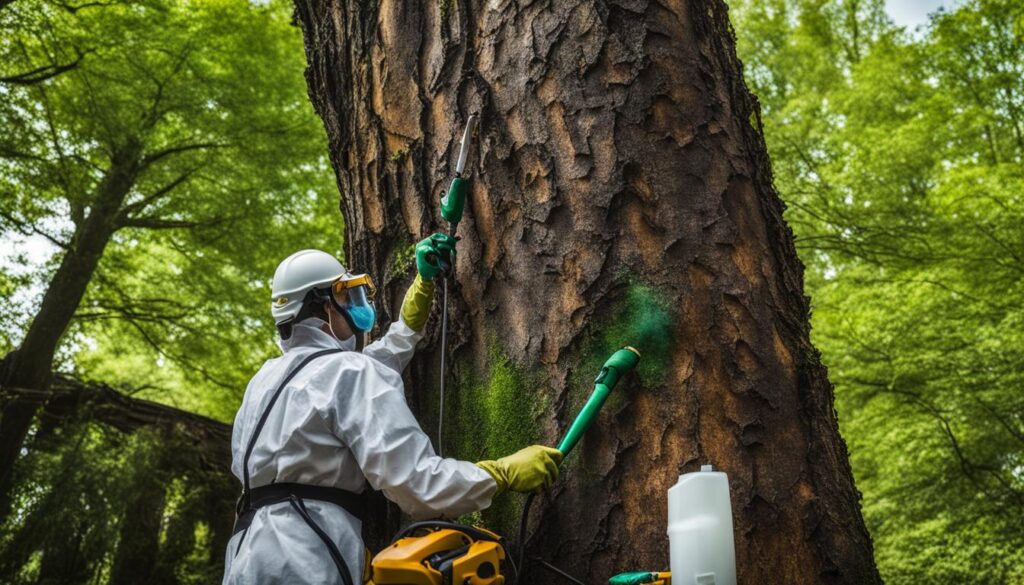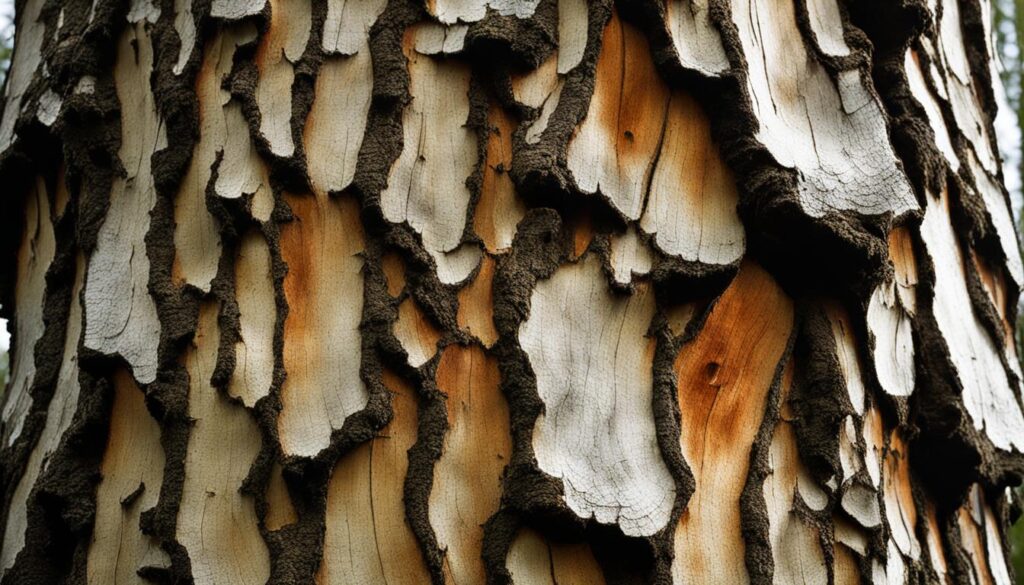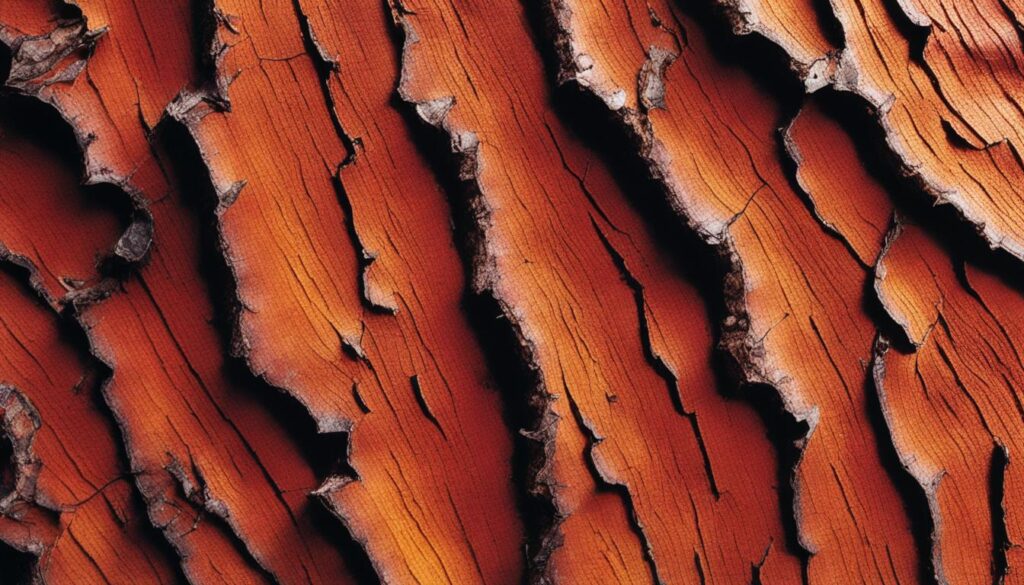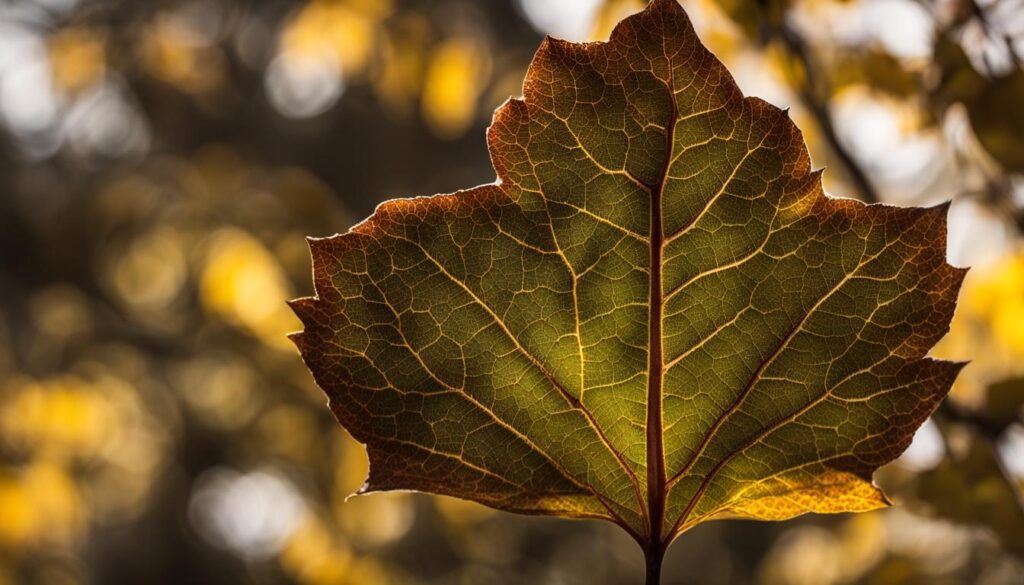Welcome to my article on Hypoxylon Canker. In this piece, I will provide you with an in-depth understanding of the diagnosis and treatment of this common infectious disease that affects various shade trees, with a particular focus on oaks. Hypoxylon Canker is caused by the fungi Hypoxylon tinctor and Hypoxylon atropunctatum, which thrive on stressed or declining hardwood trees. As a result, infected trees exhibit a range of symptoms, including yellow or brown leaves, reduced twig growth, thinning canopy, dead limbs and branches, epicormic shoots (water sprouts) growing on trunks and large limbs, and white and stringy sapwood in the cankered area. The disease is characterized by localized dead areas in the bark that can rapidly enlarge, leading to significant tree damage.
Key Takeaways:
- Hypoxylon Canker is an infectious disease that primarily affects shade trees, especially oaks.
- It is caused by the fungi Hypoxylon tinctor and Hypoxylon atropunctatum and thrives on stressed or declining hardwood trees.
- Infected trees exhibit symptoms such as yellow or brown leaves, reduced twig growth, thinning canopy, dead limbs and branches, epicormic shoots, and white and stringy sapwood in the cankered area.
- The most effective management strategy is stress avoidance, which involves promoting vigorous plant growth, avoiding tree wounds, and monitoring tree health.
- If the structural integrity of the tree is compromised, tree removal may be necessary.
What is Hypoxylon Canker?
Hypoxylon canker is an infectious disease that primarily affects shade trees, with oaks being the most susceptible. It is caused by the fungi Hypoxylon tinctor and Hypoxylon atropunctatum. The fungi take advantage of stressed or declining hardwood trees and can lead to tree decline, reduced growth, and weakened structural integrity.
Infected trees may exhibit yellow or brown leaves, reduced twig growth, thinning canopy, dead limbs and branches, epicormic shoots on trunks and large limbs, and white and stringy sapwood in the cankered area. Cankers are localized dead areas in the bark and can rapidly enlarge under humid conditions.
The disease cannot be cured, but managing tree stress is the key to prevention.
Symptoms of Hypoxylon Canker
When it comes to hypoxylon canker, recognizing the symptoms is essential for effective diagnosis and treatment. The disease manifests itself in various ways, including:
- Yellow or brown leaves: One of the first signs of hypoxylon canker is the discoloration of leaves, which may turn yellow or brown.
- Reduced twig growth: Infected trees often experience a decrease in twig growth, leading to a stunted appearance.
- Thinning canopy: The canopy of trees affected by hypoxylon canker tends to become sparse and thin as the disease progresses.
- Dead limbs and branches: As the fungus takes hold, limbs and branches may die, leading to the loss of healthy foliage.
- Epicormic shoots: In response to stress, trees may produce epicormic shoots, also known as water sprouts, on trunks and large limbs.
- Stringy sapwood: The presence of white and stringy sapwood in the cankered area is a common symptom of hypoxylon canker.
- Localized dead areas: Cankers, which are localized dead areas in the bark of stems or twigs, are a hallmark sign of the disease.
Sometimes, the healthy tissue adjacent to the canker may thicken and appear raised compared to the surrounding surface of the tree. Under humid weather conditions, cankers can rapidly enlarge, exacerbating tree damage. Additionally, the appearance of stromata, visible signs of the disease, often occurs several months after the underlying tissues die.
By identifying these symptoms, arborists and tree care professionals can quickly diagnose hypoxylon canker and take appropriate measures to manage the disease.
Causes of Hypoxylon Canker
Hypoxylon canker is primarily caused by the fungi Hypoxylon tinctor and Hypoxylon atropunctatum. However, this infectious disease mainly affects stressed or declining hardwood trees. A variety of factors can contribute to disease onset, including environmental extremes, tree wounds, construction injury, herbicide damage, and site-related stresses such as drought. When trees are already weakened, these fungi take advantage of the situation and can lead to the development of cankers.
Environmental extremes, such as temperature fluctuations or water scarcity, can weaken the trees’ immune systems and make them more susceptible to infections. Additionally, wounds on trees caused by pruning, storm damage, or natural shedding of branches provide entry points for the fungi to infect and spread within the tree’s vascular system.
Construction activities, such as excavation or damage to the tree’s root system during the construction process, can significantly stress the tree and increase the likelihood of infection. Herbicides used near trees, especially when not applied correctly, can also damage the trees’ health and make them more susceptible to diseases like hypoxylon canker.
Site-related stresses, including poor soil conditions, compacted soil, or excessive exposure to sunlight, can weaken the trees and compromise their ability to fight off infections. Similarly, water stress caused by drought conditions can negatively impact tree health and create an environment conducive to the development of hypoxylon canker.
By understanding the causes of hypoxylon canker and taking appropriate preventative measures to reduce stress and promote tree health, it becomes possible to minimize the risk of infection and the subsequent development of cankers that can rapidly enlarge under humid conditions.
Management of Hypoxylon Canker
While there is no cure for hypoxylon canker, stress avoidance is the most effective management strategy. The key to canker-free trees is prevention, which involves promoting vigorous growth through correct fertilization and irrigation, avoiding tree wounds, and monitoring tree health. Selective pruning can be done to remove dead or damaged branches and slow the advance of the fungus. In cases where structural integrity becomes questionable, tree removal may be necessary to avoid potential hazards.
Diagnosing Hypoxylon Canker
Diagnosing hypoxylon canker involves recognizing the symptoms and inspecting the appearance of cankers. Cankers are localized dead areas in the bark that may appear sunken and dead. Sometimes, the healthy tissue adjacent to the canker may thicken and appear higher than the normal surface of the tree. The appearance of stromata, visible signs of the disease, often occurs several months after the underlying tissues die. Spores of the fungus spread through splashing water and wind to healthy trees.
Treating Hypoxylon Canker
Unfortunately, there is no cure for hypoxylon canker. This disease is fatal and can rapidly lead to the death of trees. However, effective disease management strategies can help control the spread and impact of the disease.
The most crucial approach in treating hypoxylon canker is stress avoidance and prevention. By implementing proper tree care practices, including providing adequate water, nutrients, and sunlight, as well as minimizing physical damage to trees, you can help strengthen their natural defenses against the disease.
If your trees have reached a critical point where their structural integrity is compromised, tree removal may be necessary to prevent potential hazards. Removing infected trees can also minimize the chances of the disease spreading to nearby healthy trees.
Image:


Proper tree disposal is crucial in preventing the spread of hypoxylon canker. It is essential to follow local regulations and guidelines for disposing of infected trees. This can include chipping, burning, or burying the tree properly to eliminate any potential sources of infection.
While there is no cure for hypoxylon canker, taking a proactive approach to disease management through stress avoidance, tree removal when necessary, and proper tree disposal can help minimize the impact of the disease on your landscape.
Tree Damage from Hypoxylon Canker
Hypoxylon canker can cause significant damage to trees. This infectious disease can result in tree decline, reduced growth, and weakened structural integrity. As the disease progresses, infected trees become more susceptible to secondary wood rotting fungi and insect attacks. The weakened and damaged trees are more prone to wind breakage. Additionally, the development of cankers, localized dead areas in the bark, can lead to branch and limb death. The overall health and aesthetic value of the tree can be severely compromised due to the destructive nature of Hypoxylon canker.
It is crucial to address and manage this disease promptly to mitigate the potential damage to trees. Effective stress avoidance strategies and proactive tree care can help minimize the risk of Hypoxylon canker and preserve the vitality of affected trees.
By closely monitoring tree health, promoting vigorous growth, and taking preventive measures like avoiding tree wounds, tree owners can minimize the impact of Hypoxylon canker. Regular inspections and selective pruning can help remove dead or damaged branches, slowing the advance of the disease. In cases where the structural integrity of the tree is compromised, tree removal may be necessary to prevent potential hazards.
It is important to seek professional assistance in diagnosing and managing Hypoxylon canker to ensure the best outcome and preserve the beauty and functionality of affected trees.
Fungal Infection in Hypoxylon Canker
Hypoxylon canker is caused by fungal infection, primarily by the fungi Hypoxylon tinctor and Hypoxylon atropunctatum. The fungus kills the cambium and portions of the sapwood, causing sapwood decay and the development of cankers. This fungal infection compromises the structural integrity of the tree, leading to tree decline and reduced growth. The cankers that develop serve as localized dead areas in the bark of the stems or twigs. The diseased tree can become more susceptible to secondary wood rotting fungi and insect attacks. Spores of the fungus spread through splashing water and wind, facilitating the infection of nearby healthy trees.


As shown in the image above, the fungal infection in hypoxylon canker causes significant damage, particularly in the form of cankers and decay in the sapwood. The spreading of spores through wind and water increases the risk of infection in surrounding trees, contributing to the rapid spread of the disease within the affected area.
Prevention of Hypoxylon Canker
Prevention is crucial in managing hypoxylon canker. The main strategy for preventing this disease is stress avoidance. By promoting tree health through proper fertilization and irrigation, avoiding tree wounds, and monitoring the overall vigor of the tree, the risk of hypoxylon canker can be significantly reduced.
Stress avoidance plays a vital role in preventing hypoxylon canker. Ensuring that the tree receives the necessary nutrients and moisture through appropriate fertilization and irrigation practices strengthens its natural defenses against the disease. Properly nourished and hydrated trees are less susceptible to stress, making them more resilient to fungal infections like hypoxylon canker.
Avoiding tree wounds is another essential aspect of prevention. Open wounds on trees provide easy entry points for Hypoxylon fungi, increasing the risk of infection. Pruning trees selectively and properly, especially during periods of low disease activity, reduces the chances of wounds forming and helps maintain a healthy tree structure.
Regular monitoring of the overall tree health is crucial for detecting any early signs of stress or infection. By closely observing the tree’s leaves, branches, and bark, any potential issues can be identified and addressed promptly.
Control of Hypoxylon Canker
To effectively control hypoxylon canker, it is essential to focus on stress avoidance and prevention measures. One method of control is through selective pruning, which involves the removal of dead or damaged branches to impede the progression of the fungus. This is a strategic approach that can help maintain the overall health and integrity of the tree.
In critical situations where the structural integrity of a tree is compromised, tree removal may be necessary to ensure the safety of the surrounding area and prevent potential hazards. Tree disposal should be carried out properly to avoid further spread of the disease.
The effective control of hypoxylon canker is crucial in preserving the longevity and vitality of trees. By actively engaging in stress avoidance and prevention strategies and taking appropriate action when necessary, the spread and impact of this destructive disease can be mitigated.
Conclusion
Hypoxylon canker is a common infectious disease that primarily affects stressed or declining hardwood trees, with oaks being the most susceptible. Caused by the fungi Hypoxylon tinctor and Hypoxylon atropunctatum, this disease can lead to tree decline, reduced growth, weakened structural integrity, and the development of cankers.
While there is no cure for hypoxylon canker, effective diagnosis and treatment involve a proactive approach to stress avoidance and prevention. By promoting tree health through proper care, avoiding tree wounds, and monitoring tree vigor, the risk of hypoxylon canker can be minimized. Stress avoidance is essential in managing the disease.
In severe cases where the structural integrity of the tree becomes questionable, tree removal may be necessary to prevent potential hazards. It is important to dispose of the tree properly to prevent the spread of the disease.
To effectively manage hypoxylon canker, it is crucial to prioritize stress avoidance, prevention, and the monitoring of tree health. By adopting these practices, trees can be protected and the impact of this infectious disease can be mitigated.
FAQ
What is Hypoxylon Canker?
Hypoxylon canker is an infectious disease that primarily affects shade trees, with oaks being the most susceptible. It is caused by the fungi Hypoxylon tinctor and Hypoxylon atropunctatum.
What are the symptoms of Hypoxylon Canker?
Symptoms of hypoxylon canker include yellow or brown leaves, reduced twig growth, thinning canopy, dead limbs and branches, epicormic shoots growing on trunks and large limbs, and white and stringy sapwood in the cankered area.
What causes Hypoxylon Canker?
Hypoxylon canker primarily affects stressed or declining hardwood trees. Factors such as environmental extremes, tree wounds, construction injury, herbicide damage, and site-related stresses like drought can contribute to disease onset.
How is Hypoxylon Canker managed?
Stress avoidance is the most effective management strategy for hypoxylon canker. This involves promoting tree health, avoiding tree wounds, and monitoring overall tree vigor. Selective pruning can be done to remove dead or damaged branches, and in severe cases, tree removal may be necessary.
How is Hypoxylon Canker diagnosed?
Diagnosing hypoxylon canker involves recognizing the symptoms and inspecting the appearance of cankers. Cankers are localized dead areas in the bark that may appear sunken and dead. The appearance of stromata, visible signs of the disease, often occurs several months after the underlying tissues die.
Is there a cure for Hypoxylon Canker?
Unfortunately, there is no cure for hypoxylon canker. The disease is fatal and can rapidly kill trees. The most effective approach is stress avoidance and prevention through proper tree care and monitoring.
What kind of damage can Hypoxylon Canker cause to trees?
Hypoxylon canker can cause significant damage to trees. It can lead to tree decline, reduced growth, weakened structural integrity, and the development of cankers. Infected trees become more susceptible to secondary wood rotting fungi and insect attacks.
How does fungal infection occur in Hypoxylon Canker?
Hypoxylon canker is caused by fungal infection, primarily by the fungi Hypoxylon tinctor and Hypoxylon atropunctatum. The fungus kills the cambium and portions of the sapwood, causing sapwood decay and the development of cankers. Spores of the fungus spread through splashing water and wind, leading to the infection of healthy trees.
How can Hypoxylon Canker be prevented?
Prevention is crucial in managing hypoxylon canker. Stress avoidance is the main prevention strategy, which involves promoting tree health through proper fertilization and irrigation, avoiding tree wounds, and monitoring the overall vigor of the tree.
What are the control methods for Hypoxylon Canker?
The control of hypoxylon canker primarily involves stress avoidance and prevention measures. Selective pruning can be done to remove dead or damaged branches and slow the advance of the fungus. In critical cases where structural integrity becomes questionable, tree removal may be necessary. Proper tree disposal is important to prevent the spread of the disease.
What is the effective diagnosis and treatment for Hypoxylon Canker?
The effective diagnosis and treatment of hypoxylon canker involve a proactive approach to stress avoidance and prevention. By promoting tree health, avoiding tree wounds, and monitoring tree vigor, the risk of hypoxylon canker can be minimized.



